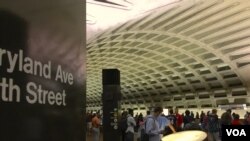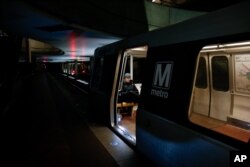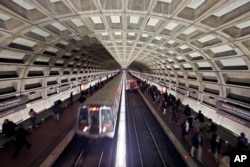Hailed as "America's Subway" when it began operating 40 years ago, Washington's Metro transit system now could serve as Exhibit A for the U.S infrastructure woes President-elect Donald Trump has vowed to fix.
Crucial to helping the federal government run smoothly, the second-busiest U.S. subway is facing falling ridership, accidents, a $290 million budget gap, job cuts and soaring costs to fix its crumbling rail lines.
Its problems became clear in March when the system shut down for a day of safety inspections following a fire. That caused commuter chaos in the nation's capital, leaving workers scrambling to find transportation via buses, carpools and bikes.
Passenger traffic has fallen nearly 20 percent from a 2009 peak, with former riders finding other ways to get to work or telecommuting to avoid the trains. This has set off a vicious cycle of lower revenues leading to service cuts and higher fares that drive more riders away.
The head of the system's largest union says the Metro is in a "death spiral," and analysts suggest its only way out could be bankruptcy or a federal takeover.
'No excuse'
Trump's vow for $1 trillion in infrastructure spending across the country offered a rare glimmer of hope to the Washington Metropolitan Area Transit Authority, which oversees the subway.
"Since he is a Republican and we have a Republican Congress, there is now no excuse for not getting this done," said authority Chairman Jack Evans, who has backed a federal takeover of the 118-mile (190-kilometer) system.
The system is of particular concern to federal officials since many of the 700,000 people who ride it each day work for the U.S. government. When it struggles to stay open during snowstorms, it often snarls government operations.
Metro is far from alone in falling behind, with subways in nearby New York and Boston also facing billions of dollars in delayed maintenance. Nationwide, the U.S. public transit system faces an $86 billion repair backlog, according to the American Public Transportation Association.
Washington's subway has long been plagued by safety systems that the National Transportation Safety Board this year called "fundamentally flawed."
Eighteen passengers and workers have died since 2005, according to the Federal Transit Administration. The agency took over safety supervision last year, the first time a subway system has come under U.S. government oversight for such lapses.
Metro General Manager General Manager Paul Wiedefeld said he would have moved a lot faster to fix some of the issues had he known the extent of the problems when he took the job a year ago.
"We are working very hard to do the best that we can for the agency and for this region," Wiedefeld said at a news conference this month. He has said the repair program will cost $60 million, but a federal report this month said the final price tag could be double that.
Design problem
Much of the trouble at Metro, which also carries many of the 21 million tourists who visit Washington each year, results from a two-track design that means trains cannot be diverted for repairs or traffic.
The system sprawls from Washington into neighboring Maryland and Virginia. It relies on those states, as well as federal and local governments, to cover close to half its costs.
Washington's Democratic mayor has proposed a 1-cent sales tax to fund the system, an idea the Virginia and Maryland governors rejected.
In a proposed $1.8 billion budget for the fiscal year beginning in July that Wiedefeld called "a reality check," Metro warned it would need to run trains less frequently and raise fares to offset declining revenue.
Metro workers flooded a board meeting this month to condemn the proposed cuts, which include hundreds of layoffs.
"Metro's budget should not be balanced on the backs of riders and workers," said Steve Williams, vice president of Teamsters Local 922.
But cost cuts are not keeping up with the decline in revenue, and Metro will have to ask for another $130 million from the District of Columbia, Virginia and Maryland to close a projected $290 million shortfall in its next budget.













